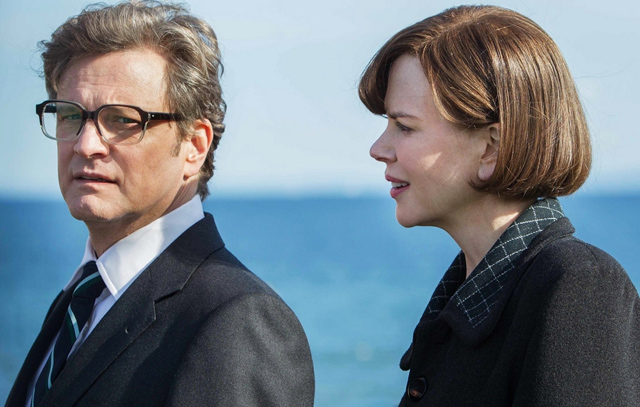CHICAGO – Excelsior! Comic book legend Stan Lee’s famous exclamation puts a fine point on the third and final play of Mark Pracht’s FOUR COLOR TRILOGY, “The House of Ideas,” presented by and staged at City Lit Theater in Chicago’s Edgewater neighborhood. For tickets/details, click HOUSE OF IDEAS.
Colin Firth, Nicole Kidman on Track in ‘The Railway Man’
 Rating: 3.5/5.0 |
CHICAGO – One of the hidden implications of World War II was the suffering of Post Traumatic Stress Syndrome (PTSD) from the millions of soldiers who survived the horrors of that war. The difficulties associated with PTSD are communicated with honor by Colin Firth in “The Railway Man”
The story is of a WWII veteran, played by Firth, whose obsessive and difficult nature is modified by a new wife, portrayed by Nicole Kidman. She seeks the truth of his behavior, and the secrets that are revealed could lead to his healing. Although the film had some real problems with timelines and composition, the sincerity behind it is authentic, and the truth of the narrative – based on the story of Eric Lomax – is reverentially displayed. Ever since “The King’s Speech,” it seems that Firth has been flailing a bit, but in “The Railway Man” he reminds us why he’s is an award-winning film actor.
Eric Lomax (Firth) is an obsessive compulsive bachelor, almost 35 years after his service in World War II as a radio engineer captured by the Japanese in Singapore. His life changes rapidly after he falls in love with Patti (Kidman), and they marry after a whirlwind relationship. They met on a train, because Eric has a lifelong obsession with locomotives.

Healing Love: Eric (Colin Firth) and Patti (Nicole Kidman) ‘The Railway Man’’
Photo credit: The Weinstein Company
Patti soon finds out that Eric has night traumas associated with his capture in WWII – he was forced to labor on the Thai/Burma Railway – and goes into a withdrawn state afterward. She consults Finlay (Stellan Skarsgard), his best friend and fellow soldier, and the story of their experiences are slowly revealed. Going between flashbacks of the actual event, and the couple’s struggles in 1980, the secrets of “The Railway Man” comes to light.
There is a feeling of a much longer film, cut down to the attention span of today’s audiences. The initial meeting and courtship of Patti and Eric is told in blur of montage-like timing, and the film suffers from this confusion. It settles when the flashbacks begin, and interestingly that becomes as important a set-up – with an excellent Jeremy Irvine portraying war-era Eric – as big stars Kidman and Firth in 1980. There were obviously some story and editing issues.
But it really comes down to the relationships, and Firth’s character must travel back to his Japanese prison, to ultimately confront his torturer. Eric was the victim of enhanced interrogation by the “Kempetai,” Japan’s equivalent of the Gestapo, a secret military police with no rules. The interaction with old foe Nagase (Hiroyuki Sanada) is the glue and essence of the film. Their scenes have a poetry to them, as both actors confront some very unique emotions, so particular to war that it has to come from a true story.
Less in focus is the modern day investigation by Patti; Kidman is used so sparingly in the film that she almost exists only as a name on a poster. And Skarsgard – last seen in the recent “Nymphomaniac” films – is even more misused, with a lack of true motivation for his actions. It feels like the modern story is tacked onto the flashbacks, as a vehicle for the name stars, and the main 1980 emotions are left for the confrontation between Nagase and Eric.

The Good War: Jeremy Irvine is the Young Eric in ‘The Railway Man’’
Photo credit: The Weinstein Company
The film does succeed, though, as an examination of the lengths that WWII trauma victims had to explore to find healing. “The Good War” was not so good in preparing the citizen soldiers for real life, especially for those who had gone through prisoner of war torture or witnessed slaughter of so many. Eric’s story is a prime example, and the path towards sanity was paved with his own intention, not the country who sent him to the conflict. The subtlety that Firth displays when he goes back to the scene of the crime is the reason to experience the film, as well as the counterpoint from Japanese actor Sanada.
In a wild movie coincidence, the railway that Eric is captured to build (the Thai/Burma) was the same as the rail line in “The Bridge on the River Kwai,” and in 1980 Nagase conducts tours associated with the film. Like some famous dialogue in “Kwai,” the fortunes of war’s experience is always, “madness, madness.”
 | By PATRICK McDONALD |


